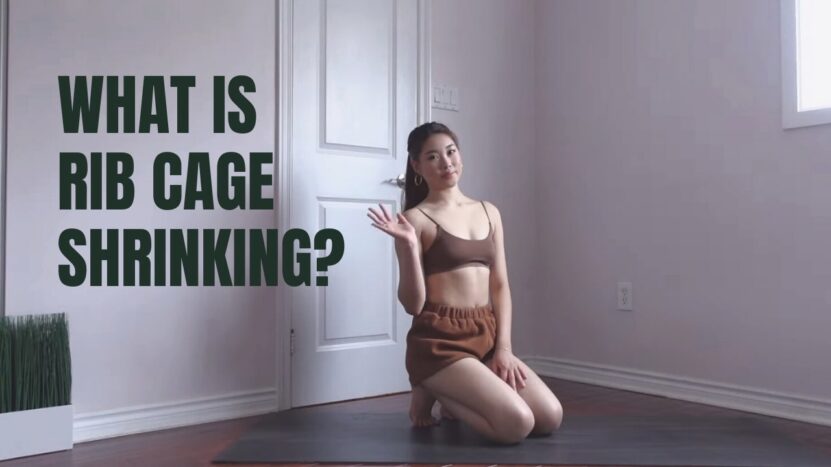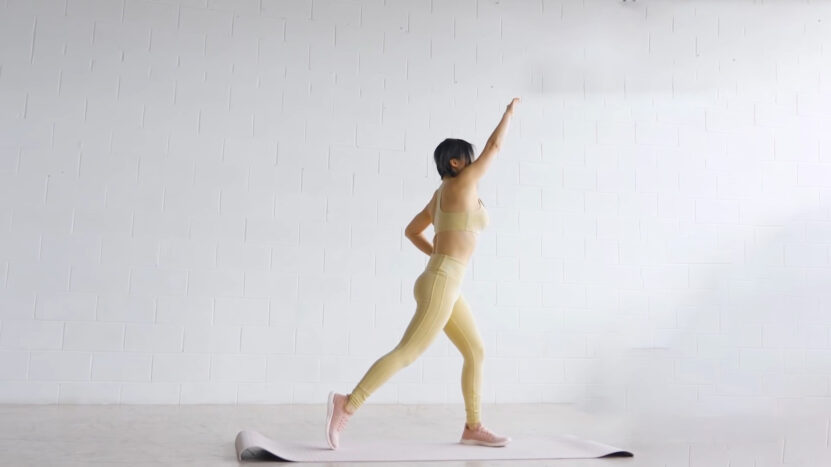Having an overly large rib cage is a common problem for many people and it can cause a range of physical and psychological issues. From back pain to self-consciousness to breathing difficulties, an oversized rib cage can dramatically affect your quality of life. Fortunately, there are steps you can take to reduce the size of your rib cage.
This guide will provide detailed instructions on how to shrink your rib cage and improve your overall well-being. First, we’ll talk about why you might benefit from reducing your rib cage, followed by safe and effective strategies such as diet modifications, exercises, yoga poses, and stretches.
Lastly, we’ll go over potential risks and complications associated with shrinking the rib cage so that you know what to expect if you decide to embark on this journey.
So here is a step-by-step guide for shrinking your rib Cage in 2023!
What is Rib Cage Shrinking?

Rib cage shrinking is a physical therapy method used for reducing pain, increasing range of motion, and improving posture. The goal is to decrease the size of your ribcage by stretching and contracting the muscles in between each rib.
This can help to correct misalignments, ease restrictions and relieve pressure from impacted nerves or discs associated with your spine. Because it works by reshaping your framework, it often takes weeks or months before the desired result is achieved – but when done consistently over time, you will be able to achieve more flexibility and less discomfort.
The technique begins with a comprehensive physical assessment where your posture is evaluated to identify any imbalances that may need correction. From there, mobility exercises are taught to target tight areas in between the ribs so they can gradually release tension over time.
It is important that these are done regularly to bring your ribs back into alignment; if left untreated or done inefficiently, this process can increase pain rather than alleviate it. As you progress through each step of the routine, you will gain greater mobility as well as improved posture leading ultimately to more comfortable movement patterns overall.
While exploring methods to shrink your rib cage for a more refined silhouette, you might also be interested in learning the art of enhancing your booty without exercise, allowing you to achieve a beautifully balanced and sculpted physique.
Benefits

Shrinking it can help improve your body’s overall shape and appearance as well as provide numerous health benefits. These benefits include:
1. Better posture
Shrinking your rib cage can help improve your posture, particularly in older individuals who have lost some of their natural spine elasticity and flexibility. By shrinking the rib cage, you can help support the spine, preventing slouching and hunching.
2. Reduced pain
For individuals with osteoporosis or other bone diseases affecting the thoracic (rib) region, reducing the size of the ribs may also reduce pain in that region. This is often beneficial when performing physical activities such as dancing or running, as it reduces strain on weakened bones.
3. Improved athletic performance
The narrower dimensions of a shrunken rib cage make it easier for athletes to perform certain movements more efficiently by allowing them a greater range of motion during those movements. Additionally, this lower body weight from a shrunken rib cage may reduce drag in water-based sports such as swimming or rowing.
4. Enhanced physical appearance
One of the main reasons some people choose to shrink their rib cages is because they believe doing so will give them an enhanced physical appearance. A smaller ribcage means smaller breasts and waistlines, which can have cosmetic appeal for both men and women alike.
Preparation

Shrinking your rib cage can seem like a daunting process, but with careful preparation, it can be achieved safely and effectively.
Before you begin shrinking your rib cage, there are a few things you should prepare such as ensuring you have enough time and space to complete the process, gathering the necessary materials, and consulting with a medical professional if necessary.
Let’s get started with the preparation step.
Consult with a doctor
Before attempting any rib cage shrinking regimens, it is important to consult with a healthcare professional to determine whether this treatment is appropriate for you.
Your doctor should be able to review your general health, physical attributes, and lifestyle to provide tailored advice and guidance on the best exercises and other strategies that could aid you in properly shrinking your rib cage.
During the consultation, it is also important to discuss any existing medical conditions or diseases, such as scoliosis or thoracic spine disorders that could negatively affect the results of the treatment. Additionally, discussing any current medications or supplements you are taking can be beneficial in order for your doctor to identify potential side effects of rib cage shrinking regimens.
Consulting with a healthcare provider prior to beginning any regimen can ensure a successful outcome and help prevent more serious conditions from developing.
Get the necessary equipment

In order to achieve the best results from shrinking it, it is essential to have the correct equipment. Before you begin, check that you have access to the following:
- Adjustable workout bench: This will enable you to vary your exercises between chest presses, inclines, and seated cable flies.
- Resistance bands: These are ideal for achieving high levels of tension while performing rib-shrinking exercises such as bent-over rows, pullovers and lateral raises.
- Weight plates: Those who have access to free weights or adjustable dumbbells should include these in their routine – they will allow you to increase the intensity of your workouts over time by adding extra weight as needed.
- Stability ball: Exercises performed on a stability ball can activate more muscles and help you reach deeper levels of muscle contraction – these are essential for targeting the deep muscles that support your rib cage and spine, enabling you to continue making progress even after reaching an advanced level.
- Mat or towel: It’s important to protect yourself from slipping or dropping weights – for this reason, it is highly recommended that you use some form of padding during your workouts (a yoga mat or large towel will do).
Step-by-Step Guide
If you’re looking to shrink your rib cage, this guide will be a useful resource for you. In this step-by-step guide, we’ll discuss the best exercises, diets, and tips you can implement today to reduce the size of your rib cage. Let’s get started.
Step 1: Warm Up

Before performing any exercise to shrink your rib cage, it is important to warm up your body. This prepares the muscles and connective tissues for the safe and effective execution of the moves. A five-minute cardio routine or brief stretching session should suffice as a warm-up.
If necessary, use some light dumbbells or resistance bands to provide additional resistance and help you complete the exercises with greater ease. Make sure that you maintain good form throughout the entire workout for maximum efficacy and safety.
Also, keep in mind that these exercises should not be done in an isolated manner; rather, they should be included in an overall fitness program consisting of a variety of physical activities such as cardio, strength training, core work, flexibility coaching, and so forth.
Remember to drink plenty of fluids before, during, and after each workout session to stay hydrated and reap maximum benefits from every move!
Step 2: Start Breathing Exercises
The best way to get started on the journey of creating a smaller rib cage is to begin with breathing exercises. Here are a few of the most common breathing exercises:
- Diaphragmatic Breathing: Also known as deep breath or belly breathing, diaphragmatic breathing will help you connect to and strengthen your diaphragm and abdomen muscles. Begin by lying on your back with one hand resting near your waist for pressure monitoring. Inhale slowly through your nose and notice how your lungs fill up and your hand rises with the breath. Exhale through your mouth slowly and consciously, allowing you to feel the air release from the lungs and downwards towards the spine. Try to build up to 10 repetitions over time!
- Alternate Nostril Breathing: Also called Nadi Shodhana, this is an ancient practice consisting of alternate inhalation of each nasal chamber while alternatively blocking one nostril at a time and then releasing and repeating with the other nasal field. It helps activate both sides of the brain for balance, releasing metabolic products and calming anxiety symptoms for overall well-being that can help eventually lead to decreasing rib cage size over time.
- Ujjayi Breath: This pranayama breath technique has been used in yoga practice for many years as it enhances meditation practice and heightens focus levels resulting in increased awareness which is essential when wanting to reduce rib cage size, as understanding the body signals can minimize unnecessary massaging movements performing incorrect physical practices or overenthusiasm when sensibly carrying on workouts for achieving specific body goals or reducing certain body parts size over time!
Step 3: Perform Ribcage Shrinking Exercises
Now it’s time to start shrinking your ribcage! To do this, you need to focus on working the muscles in your back, shoulders, chest, and abdominals.
- Back – Start with a seated row using some resistance bands or weights. Pull the bands/weights back toward you and hold for a few seconds before slowly releasing. Do 12-15 repetitions for 3-4 sets of this exercise, resting for 30 seconds between each set.
- Shoulders – Dumbbell military presses are an effective exercise for toning and strengthening your shoulders as well as shrinking your ribcage. Hold a dumbbell in each hand and raise both of them above your head until your elbows are locked out straight. Slowly lower both arms until they are at shoulder height before pressing them up again and repeating 12-15 times in 3-4 sets with a 30-second rest between sets.
- Chest – Push-ups work great to target the pectoral muscles and reduce the size of your ribcage over time. Start on all fours then lower yourself down to just above the ground until both arms are bent at 90 degrees forming an L shape with your body in relation to the floor surface, hold for a few seconds then press back up using both hands evenly allowing only minimal support from your toes and legs if needed! Aim for 8-12 repetitions per set while doing 3-4 sets of this exercise incorporating a 30-second rest period between each set!
4 Abdominals – Finally finish off your rib cage shrinking routine by performing abdominal exercises such as sit-ups or crunches targeting the core muscles around your waistline! Make sure to perform 12-15 reps of each exercise per set while resting usually no longer than 15 seconds between 3 sets!
Remember that consistency is key when trying to shrink any part of your body; so make sure you dedicate yourself properly to see good results over time.
Step 4: Cool Down

Once you have completed Step 3, as outlined above, it is important to cool down in order to prevent any cramping or muscle soreness. This can be done by performing gentle stretches and various other activities that promote relaxation and healing.
The objective at this stage is to gradually reduce your body temperature, which will help the muscles in your rib cage relax, allowing for a decrease in size over time. Activities such as light walking or jogging at a steady pace for approximately 20 minutes are effective ways of promoting restorative cooling down. Alternatively, swimming in a heated pool can provide a great form of relief for both the muscles and joints.
If possible it is advisable to perform stretching exercises such as circling your arms or gently moving them back and forth from one side to the other. This helps create balance within your body and aids the cooling process by aiding the circulation of blood around your body, particularly within the rib cage area.
To further aid circulation, breathing exercises can also be beneficial although should be performed more slowly than normal so that you are able to feel each breath enter and leave your lungs thoroughly.
FAQs
1. Can wearing a corset or waist trainer shrink your rib cage?
Wearing a corset or waist trainer may temporarily compress your rib cage and make it appear smaller, but it will not physically reduce its size.
2. Can weight loss help shrink your rib cage?
Yes, losing weight can help reduce the amount of fat and muscle around your rib cage, making it appear smaller.
3. Will shrinking your rib cage affect your breathing?
Reducing the size of it will not affect your breathing as long as it is done in a healthy way and you maintain proper posture.
4. Can genetics affect the size of your rib cage?
Yes, genetics can play a role in its size and shape of it.
5. Is surgery an option for shrinking your rib cage?
Surgery to physically reduce its size is not a common procedure and should only be considered for medical reasons.
6. Can wearing tight clothing shrink your rib cage?
Wearing tight clothing may temporarily compress it and make it appear smaller, but it will not physically reduce its size.
7. Can yoga help shrink your rib cage?
While yoga can help improve posture and reduce overall body fat, there are no specific yoga poses that target it.
8. Are there any health risks associated with trying to shrink your rib cage?
Attempting to physically reduce it can be dangerous and is not recommended. However, reducing the amount of fat and muscle around the area through healthy lifestyle habits is safe and beneficial for overall health.
Conclusion
The anatomy of the rib cage is complex, and the process of shrinking it can be a difficult task. However, with the right knowledge and preparation, you can achieve successful results when attempting to reduce its size.
By improving your nutrition, reducing stress levels, cautious exercise, and mindful breathing techniques you can begin to reduce the size of your rib cage. Remember to always consult with a healthcare professional before beginning any new diet or exercise program.
If at any time you experience pain, shortness of breath or other health-related issues during your journey towards rib cage reduction, immediately seek medical advice from your healthcare provider.
By implementing dietary changes and following an exercise plan specifically tailored for achieving smaller ribs, you can have some successful results in reducing your rib cage size over time. With determination and commitment you may find shrinking your ribs surprisingly easy – proving that anything is possible when we take care of ourselves and set out on the right path with guidance.

